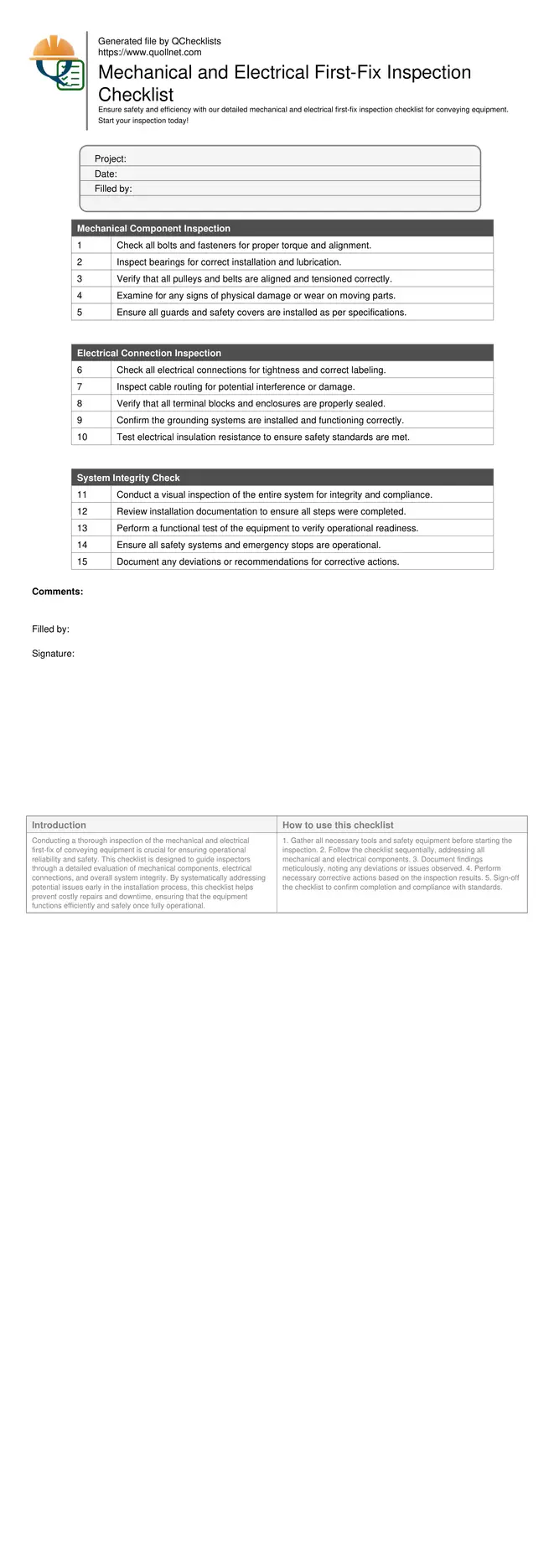Comprehensive First-Fix Inspection for Conveying Equipment
Conducting a thorough inspection of the mechanical and electrical first-fix of conveying equipment is crucial for ensuring operational reliability and safety. This checklist is designed to guide inspectors through a detailed evaluation of mechanical components, electrical connections, and overall system integrity. By systematically addressing potential issues early in the installation process, this checklist helps prevent costly repairs and downtime, ensuring that the equipment functions efficiently and safely once fully operational.
- Ensure mechanical components are correctly installed to prevent future malfunctions.
- Verify electrical connections to maintain system safety and reliability.
- Identify and address installation errors early to reduce potential downtime.
- Enhance operational efficiency through detailed inspection and documentation.
- Support regulatory compliance by following structured inspection procedures.
Mechanical Component Inspection
Electrical Connection Inspection
System Integrity Check
Importance of Mechanical Inspection
Mechanical components are the backbone of conveying equipment, and their proper installation is vital. Any misalignment or incorrect assembly can lead to significant operational inefficiencies or failures. A thorough inspection helps identify these issues early, ensuring that the equipment runs smoothly and safely.
- Check for proper torque on bolts and fasteners.
- Inspect bearings for alignment and lubrication.
- Ensure pulleys and belts are correctly tensioned.
Critical Electrical Connection Checks
Electrical connections are crucial for the safe and efficient operation of conveying systems. Properly installed and maintained electrical systems prevent hazards such as short circuits or electrical failures. This section ensures that all connections are secure, labeled, and compliant with safety standards.
- Verify tightness and labeling of connections.
- Inspect cable routing for damage.
- Test insulation resistance for safety compliance.
Ensuring System Integrity
The overall system integrity check ensures that all components work together seamlessly. This includes verifying that all installation steps have been followed and that the system is ready for operation. Functional testing and documentation are key to this process, ensuring that the equipment is both reliable and compliant.
- Conduct a visual system inspection.
- Perform functional tests for readiness.
- Document deviations and corrective actions.
How to Use the Mechanical and Electrical First-Fix Inspection Checklist
- Gather all necessary tools and safety equipment before starting the inspection.
- Follow the checklist sequentially, addressing all mechanical and electrical components.
- Document findings meticulously, noting any deviations or issues observed.
- Perform necessary corrective actions based on the inspection results.
- Sign-off the checklist to confirm completion and compliance with standards.
Call to Action
-
Start Interactive Checklist
Tick off tasks, leave comments on items or the whole form, and export your completed report to PDF or Excel—with a built-in QR code for authenticity.
- Download Excel - Mechanical and Electrical First-Fix Inspection for Conveying Equipment
- Download PDF - Mechanical and Electrical First-Fix Inspection for Conveying Equipment
- View Image - Mechanical and Electrical First-Fix Inspection for Conveying Equipment

